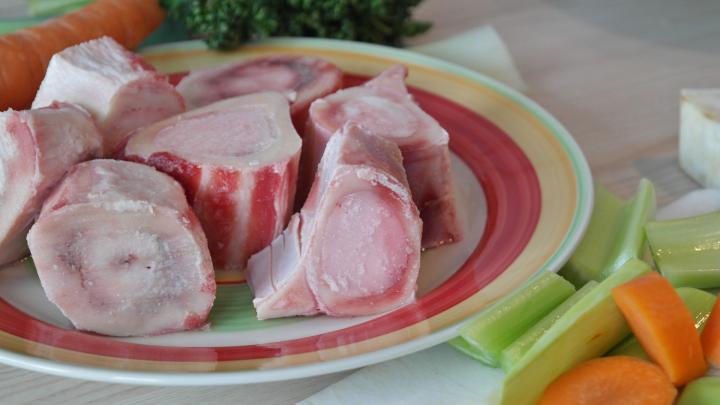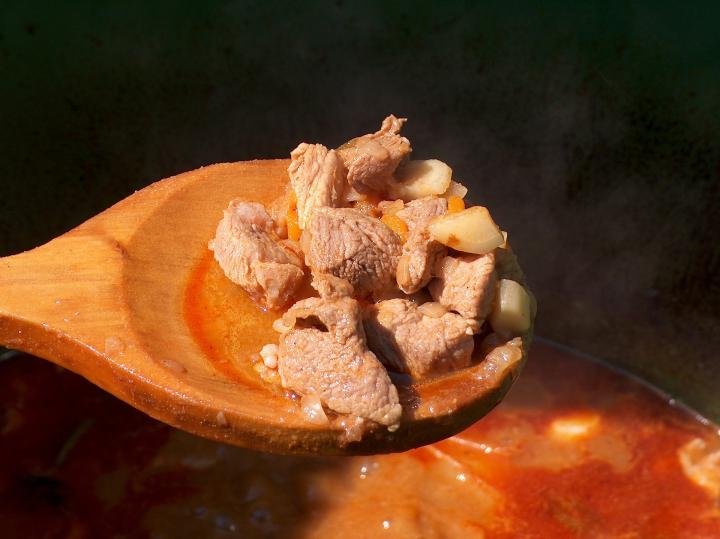Incorporating bones into your cooking improves the flavor of soups and stews while also offering health benefits, so we’ll show you how to do it and provide some great recipes!
The world’s most sumptuous cuisines have been founded on the prudent use of the 20 percent of the frequently discarded animal—the bones. Long ago in France, cooks had the eternal kettle, a large pot that never left the fire. If a piece of meat was removed, a new piece was added. Whenever stock was removed, water was added, resulting in a steady supply of delicious stock and a ready pot for quickly boiling meats. The next time you visit your farmers’ market, look past the rib eye steaks and the lamb chops, meet your farmer eye-to-eye, and say, “Got any bones?”
A broth or stock, which is made using bones, typically contains the five basic ingredients of bones, vegetables, herbs, water, and acid (vinegar or wine). Nearly anything you can find in your kitchen can be added to a broth or stock to enrich its flavor and nutritional value.
Technically, stock is made by simmering bones (or shells) and vegetables in water, while broth is made by simmering meat (such as pork, beef, poultry, or fish) and/or vegetables in water. Stocks tend to be thicker than broths due to the collagen in the bones and connective tissue. In common usage of the terms, this subtle difference is sometimes lost!
Ingredients for a Broth or Stock
The Bones:
A pure beef or chicken stock is lovely, but good stocks result from mixing ingredients. Toss into your pot the leftover bone from Monday night’s rib-eye steak or the remains from Sunday’s leg of lamb. If you’re buying bones, remember that knucklebones and oxtails are a great source of gelatin. Neck, rib, and other meaty bones add color and flavor. Marrow bones and cross sections from the legs add flavor and minerals.
The Vegetables:
Use fresh veggies but also broccoli that is about to flower; carrots gone floppy; peppers, tomatoes, and onions growing soft on the kitchen counter; and any leftover cooked vegetables.
The Herbs:
Make a bouquet garni (a bundle of herbs) by tying fresh herbs together with a piece of kitchen string before adding them to the stockpot. If using dried herbs, make a cheesecloth sachet so they are easily removed.
The Acid:
Use vinegar or wine to taste—as little as a tablespoon of vinegar or as much as a few cups of wine. The acid draws minerals out of the bones and improves the flavor.
The Simmer:
The longer you simmer a stock, the better. Twelve hours is sufficient, but 72 hours is better. (The stockpot can simmer all day, be turned off at bedtime, and then be turned on again the next morning.) Add more water if the liquid level gets below the top of the bones.

Basic Meat Stock (“Bone Broth”) Recipe
- 4 pounds bones (beef, lamb, pork, and/or poultry)
- 2 large carrots, cut into large chunks
- 3 ribs celery, cut into large chunks
- 2 onions, peeled and quartered
- 7 quarts water
- 3 to 4 sprigs oregano, or 1 teaspoon dried
- 3 cloves garlic, unpeeled and crushed
- 1 tomato, coarsely chopped
- 2 teaspoons salt
- 2 tablespoons vinegar or 1 to 2 cups wine
Preheat the oven to 450ºF. Place the bones and the vegetables in a large roasting pan and roast for 40 minutes or until the bones have thoroughly browned. Periodically turn them over, basting with any accumulated fat drippings. Pour the bones and vegetables into a very large stockpot.
Set the pan, with drippings, on the stovetop, and pour in 2 cups of water. Over medium heat, bring the water to a simmer. Scrape up the browned bits and add the water and bits to the stockpot. Add the remaining ingredients. Rest the stock for 30 minutes to 1 hour.
Bring the stock to a boil slowly, skimming off any scum that rises to the surface. Reduce the heat to low and simmer the stock for 12 hours, minimum, remembering to keep a sufficient fluid level.
Remove and discard all of the bones, vegetables, and herbs. Cool the stock to room temperature and refrigerate. Once cold, it should be firm, like gelatin. If it does not congeal, it’s still okay—this simply means that its richness is less than ideal. Skim off any fat before using. Use the stock immediately or pack it into freezer containers and freeze. Makes 4 to 5 quarts.
Using Homemade Meat Stock
Now that you’ve got your homemade meat stock try it in the recipes below!
Goulash Recipe
- 1 cup flour
- 2 tablespoons coarse salt
- 1 tablespoon ground black pepper
- 2 tablespoons sweet paprika, divided
- 3 pounds beef stew meat, oxtails, bone-in shanks, or short ribs
- 4 tablespoons butter, lard, or a combination of the two, plus more if necessary
- 6 onions, sliced thin
- 1 tablespoon Hungarian paprika
- 1 quart stock or broth (any kind)
- 2 tablespoons orange zest (optional)
- 1/2 cup white wine
- 2 cups sour cream
- egg noodles
- butter (optional)
- 2 teaspoons caraway seeds
Combine the flour, salt, pepper, and 1 tablespoon of sweet paprika. Dredge the meat in the mixture, then sauté in the butter over medium heat in a nonreactive Dutch oven until browned, working in batches if necessary. Use more butter or lard if your pan becomes dry.
Return all of the beef back to the pan, then add the onions. Stir in the Hungarian paprika, remaining sweet paprika, stock, orange zest, and wine. Simmer over low heat, stirring constantly and incorporating any browned bits into the sauce. Cover and simmer over low heat for 2 to 3 hours, or until the meat is fork-tender. Check occasionally for liquid, adding more white wine, water, or stock, if necessary. When the meat is cooked, stir in the sour cream and heat through, but do not boil. Prepare the noodles according to the package directions. Serve the goulash over buttered noodles and sprinkle with caraway seeds. Makes 6 to 8 servings.
Slow Cooker Goulash: Dredge the meat and sauté (in a skillet) as described above. Put the onions into a large slow cooker and layer the browned meat on top. Combine the stock and wine in a shallow saucepan. Simmer over medium heat until reduced by half. Pour the liquid into the slow cooker, and add the remaining ingredients, except the sour cream and noodle fixings. Cook on low for 4 to 6 hours, until the beef is fork-tender. Stir in the sour cream and heat through (do not allow to boil). Serve as noted above.

Curried Lamb Recipe
- 3 to 4 pounds lamb shanks and/or meaty neck bones
- salt and ground black pepper, to taste
- 1/4 cup olive oil, lard, or butter
- 1 large onion, chopped
- 3 to 4 cloves garlic, minced
- 1 tablespoon grated fresh ginger
- 2 teaspoons cumin
- 1 teaspoon freshly ground cardamom
- 2 cinnamon sticks
- 4 whole cloves
- 1/2 teaspoon cayenne pepper, or to taste
- 1 teaspoon turmeric
- 1 can (6 ounces) tomato paste
- 1 cup stock or broth (any kind)
- 1 large or 2 small boiling potatoes, cut into bit-size chunks
- 1/2 cup fresh cilantro (optional)
- couscous or rice
Sprinkle the lamb with salt and pepper. Heat the oil in a large, deep skillet over medium heat, add lamb, and brown on all sides. Remove the meat to a dish.
Add the chopped onion to the skillet and sauté until translucent. Stir in the garlic and cook for 1 minute. Add the ginger, cumin , cardamom, cinnamon sticks, cloves, cayenne pepper, and turmeric. Mix thoroughly. Stir in the tomato paste and stock. Return the meat to the skillet and mix to coat.
Reduce the heat to low, cover, and simmer until the meat is tender, 45 minutes to 1 hour. Add the potatoes, cover, and cook 30 minutes longer, or until they are tender.
In the meantime, prepare the couscous or rice according to the package directions. Add the cilantro to the skillet, stir, and simmer, uncovered, for 10 minutes. Remove the cinnamon sticks and serve over couscous or rice. Makes 3 to 4 servings.
Desperate for more recipes now that you’ve got all this bone broth and stock on your hands? Check out our hearty soups and stews that make for great dinners, especially with your homemade broth.











